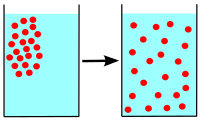
Photo from wikipedia
Abstract Turbulent or eddy diffusion models are used to predict spatially resolved exposures to toxic airborne materials in indoor environments. The single parameter that governs mixing in these models is… Click to show full abstract
Abstract Turbulent or eddy diffusion models are used to predict spatially resolved exposures to toxic airborne materials in indoor environments. The single parameter that governs mixing in these models is the eddy diffusion coefficient. Some relationships that enable this coefficient to be predicted have been proposed in the literature, but wider applicability of these has not previously been tested. In this paper an automated computational fluid dynamics tool was used to calculate the eddy diffusion coefficient in a range of isothermal, mechanically ventilated rooms. Available models for the diffusion coefficient were then tested and the most applicable was found to be one based on a turbulent kinetic energy balance. This relationship was only appropriate when the characteristic length was set to a dimension of the air supply inlet, instead of the length usually applied, i.e. the room height. The validity of this relationship was further demonstrated using experimental test cases and by applying standard error metrics. The eddy diffusion approach can now be used with improved confidence in a wider range of scenarios than was possible before.
Journal Title: Building and Environment
Year Published: 2020
Link to full text (if available)
Share on Social Media: Sign Up to like & get
recommendations!